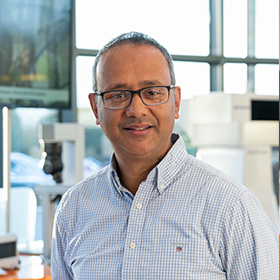Employee perspectives - Manish Jadeja
I'm an engineer because the sector values creative thinking.

How many engineers does it take to change a lightbulb? Considering the R&D in fluorescent, halogen and LED bulbs — not to mention today's smart lightbulbs — changing its design requires a fair few. If you want to investigate it further, you can consider the design, mechanical, electrical and software engineers involved in developing smart technology.
Here Manish Jadeja, Industrial Metrology Production Manager at Renishaw, discusses the value of diverse skill sets in product development projects.
The example of the lightbulb alone demonstrates that the engineering industry demands multiple skill sets. Then, when you factor in all the industries that require some form of engineering and all the roles involved in researching, developing and manufacturing products, the need for innovative thinking increases. The industry must be on the front foot of shifting market needs, regulatory requirements and global issues such as changing environmental conditions. This means the engineering industry is constantly developing new tools, techniques and materials, all of which require engineers to work together to apply their skills and knowledge.
A multi-disciplinary approach
The variety of disciplines in the sector provides engineers with an exciting opportunity to thrive in different positions and gain exposure to new ways of applying their skills. Fortunately, unlike some careers, where progression is vertical or linear, many engineering firms actively encourage movement across different disciplines.
Exposure to different departments was instrumental in shaping my career. Before I started my apprenticeship, I hadn't experienced any part of engineering outside the assembly floor. Rotating through different departments, such as production engineering, purchasing, vendor assurance, sales and the machine shop, gave me an appreciation for different roles, as well as an understanding of the close links between disciplines.
Most projects require some form of problem-solving — having a broader perspective enables engineers to approach problems from various angles and develop innovative solutions that incorporate techniques from multiple disciplines. Encouraging teams to think laterally and explore alternative approaches is key when developing a new product and bringing it to market. One of the recent projects I have been involved with is a perfect example of how this team structure and culture leads to success.
Our team, made up of production technicians, process engineers, manufacturing engineers and designers, as well as purchasing and marketing engineers and project managers, was presented with a new project. The opportunity, albeit a challenging one, was to develop and introduce an important new measuring system for Renishaw, with ambitious timescales. Together, the team tried different techniques and explored alternative methods to solve issues together and produce a product that met customer requirements, while adhering to challenging timescales. As a result, the project felt like a dynamic new start-up, with a highly motivated team embracing the opportunities to cross boundaries and collaborate closely, which ultimately resulted in the successful introduction of the product.
Encouraging diversity
Diversity in individual experience is important, but what about the wider team? Renishaw understands that the engineering industry must also find ways to attract talented people from diverse backgrounds. However, this is not always easy, particularly for businesses located in rural areas such as Gloucestershire, where Renishaw's head office is based.
To tackle this challenge, Renishaw has built an Equality, Diversity and Inclusion (EDI) Group. As a longstanding employee from a Black, Asian and minority ethnic (BAME) background, I jumped at the chance to contribute. Continuous engagement with existing employees, the local community and proactive education outreach with students has already resulted in positive changes in diversity across the business.
The engineering industry needs to foster a culture of diversity — both in individual experience and background. At Renishaw, we understand the value this diversity can bring to the company, its people and the technologies we develop. It has been instrumental in my career, and in that of many others.
So, how many engineers does it take to change a lightbulb? Ideally, a lot of them.
Biography
- Joined Renishaw in 1990 in the electronics assembly line before starting an engineering apprenticeship.
- After moving around divisions and working on various roles in production engineering, Manish moved to production management in the new product development areas
- Currently Industrial Metrology Production Manager
- A member of Renishaw's Equality, Diversity and Inclusion Group